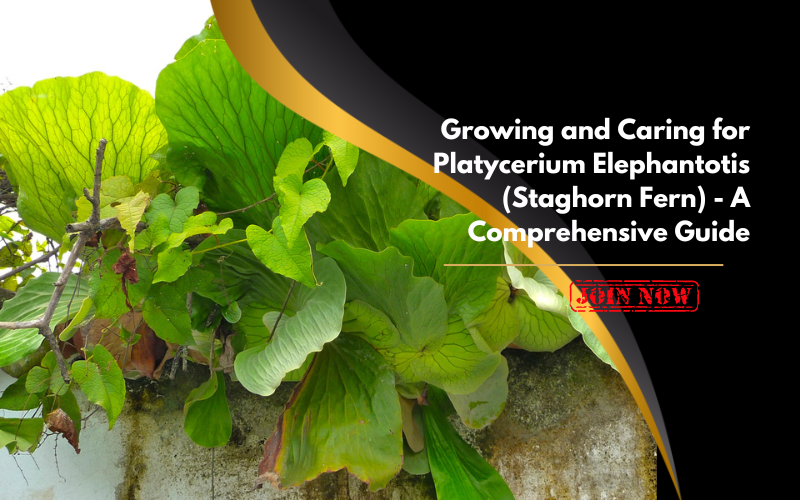+91 9493616161
+91 9493616161

Introduction
Platycerium elephantotis, commonly known as the Staghorn Fern, is a unique and beautiful plant that belongs to the Polypodiaceae family. This plant is native to tropical regions of Africa, where it grows naturally on trees, rocks, and in the soil. The plant is famous for its stunning foliage, which is shaped like antlers, hence the name 'Staghorn Fern.'
The Platycerium elephantotis is a popular choice for gardeners and houseplant enthusiasts alike, as it's relatively easy to care for and can make a stunning statement in any room or garden. In this guide, we'll cover everything you need to know about the Platycerium elephantotis, from its characteristics and ideal growing conditions to its propagation and care.
Characteristics
The Platycerium elephantotis is a relatively large plant that can reach up to 4 feet in height and 3 feet in width. Its unique foliage is what sets it apart from other ferns, with its antler-like fronds that grow from a central base. The plant produces two types of fronds, the first being the sterile fronds that form the base of the plant, and the second being the fertile fronds that develop at the top.
The sterile fronds are broad, flat, and shield-shaped, and they can grow up to 2 feet in length. They serve as a protective layer for the plant's roots and are typically green or grayish-green in color. The fertile fronds, on the other hand, are much narrower and longer than the sterile fronds, growing up to 3 feet in length. They have a unique antler-like shape and are typically brown or bronze in color.
The Platycerium elephantotis is an epiphytic plant, meaning that it grows on the surface of other plants or objects rather than in soil. It attaches itself to its host using rhizomes, which are modified stems that help the plant absorb water and nutrients from the air.
Ideal Growing Conditions
The Platycerium elephantotis is a relatively easy plant to care for, but it does require specific growing conditions to thrive. Here are the ideal growing conditions for this plant:
Light: The Staghorn Fern prefers bright, indirect light. Direct sunlight can scorch its delicate fronds, while too little light can cause the plant to grow slowly or stop growing altogether. Placing the plant near a window that receives plenty of light, but not direct sunlight, is ideal.
Temperature: This plant thrives in warm, humid conditions. It prefers temperatures between 60 and 80 degrees Fahrenheit and should be kept away from cold drafts or extreme heat.
Humidity: As an epiphytic plant, the Platycerium elephantotis requires high humidity to grow properly. Ideally, the plant should be kept in an environment with humidity levels between 50% and 70%. You can increase the humidity around the plant by placing a tray of water near it or using a humidifier.
Watering: This plant prefers to be kept moist but not waterlogged. Overwatering can lead to root rot, which can be fatal for the plant. The frequency of watering will depend on the environment in which the plant is growing, but typically once a week is sufficient.
Soil: As an epiphytic plant, the Platycerium elephantotis doesn't require soil to grow. Instead, it can be mounted on a board or hung in a basket with sphagnum moss. If you prefer to grow the plant in soil, use a well-draining, peat-based mix.
Propagation
The Platycerium elephantotis can be propagated through spores or by dividing
Care
The Platycerium elephantotis is a relatively low-maintenance plant, but it does require some specific care to ensure it thrives. Here are some care tips to keep in mind:
Watering: As an epiphytic plant, the Staghorn Fern doesn't need to be watered as frequently as plants that grow in soil. Water the plant when the soil or moss feels dry to the touch. Avoid getting water on the fronds, as this can cause them to rot.
Fertilizing: Feed the plant with a balanced, water-soluble fertilizer once a month during the growing season (spring and summer). Do not fertilize the plant during the winter months when it's dormant.
Pruning: Remove any dead or damaged fronds from the plant as soon as possible to prevent disease and encourage healthy growth.
Repotting: The Platycerium elephantotis doesn't need to be repotted very often, as it's a slow-growing plant. Repot the plant only when it becomes too large for its current container.
Pests and Diseases: The Staghorn Fern is relatively pest and disease-resistant, but it can be susceptible to mealybugs and scale insects. If you notice any signs of infestation, treat the plant with an appropriate insecticide or a solution of neem oil and water.
Conclusion
The Platycerium elephantotis, or Staghorn Fern, is a unique and beautiful plant that's relatively easy to care for. With its antler-like fronds and epiphytic nature, it's a great addition to any room or garden. By providing the plant with the ideal growing conditions, propagating it through spores or division, and providing it with proper care, you can enjoy the beauty of this plant for years to come.
Comments
Leave a comment